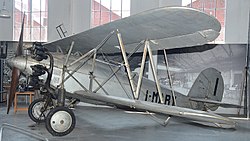| Ca.113 | |
|---|---|
 | |
| General information | |
| Type | Civil trainer aircraft |
| Manufacturer | Caproni, Kaproni Bulgarski |
| History | |
| First flight | 1931 |
The Caproni Ca.113 was an advanced training biplane produced in Italy and Bulgaria in the early 1930s. Designed as a follow-on to the Ca.100, it was a more powerful and robust aircraft capable of aerobatics. It was a conventional design with two cockpits in tandem, single-bay staggered wings of equal span, and mainwheels covered by large spats.
Contents



